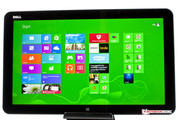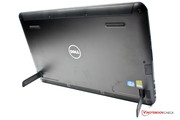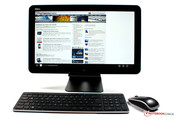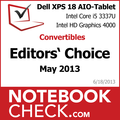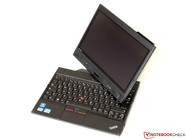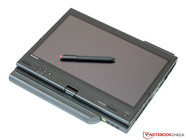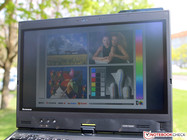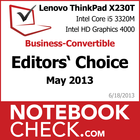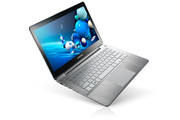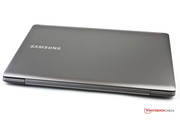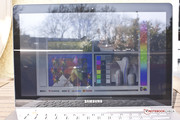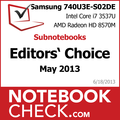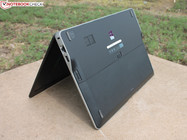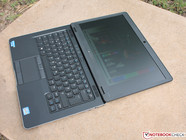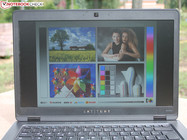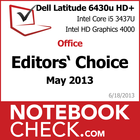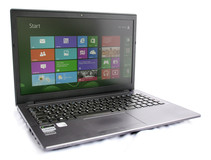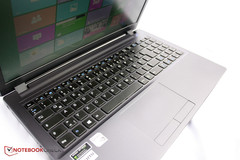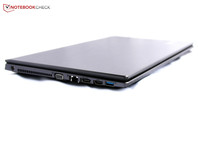Notebookcheck's Best of May 2013 - Notebooks and Convertibles
For the original German article, see here.
Looking back through May 2013, which devices did we like best? Splitting the notebooks into four categories, for each category we compare laptops in the same class and dub one the winner. Tablets (Android/Windows RT) and smartphones were selected in a separate article: Best of May 2013 – Smartphones and Tablets.
May only brought 15 notebooks into the hands of our editorial staff. The reason: On June 1, 2013, the chip giant Intel introduced their new processors and integrated graphics cards. It follows, of course, that none of the devices we reviewed in May are equipped with Intel's brand new Haswell platform. But on June 1 a flood of pre-prepared Haswell reviews promptly went online. See for example:
- In Review: Intel Haswell Processors
- Intel HD Graphics 4600
- One K56-3N2 (Clevo P157SM)
- MSI GT70H
Convertibles
Contenders:
Although they couldn't be more different (11.6- to 18-inches), our ratings for the May convertible notebooks all fell within the high quality range of 86 to 87%, with only one exception. Notebookcheck's rare grade "Very Good" starts at 88%. Dell's Windows convertible PC doesn't just come in an extremely big box: It's the biggest portable Windows tablet on the market to date. There is of course the recently released Sony Vaio Tap 20, but at a weight of 5 kilograms (11 lbs), this 20-incher is clearly an all-in-one (AIO), even if it has a battery and can be moved around from room to room. The XPS 18 made a good impression with its first-class manufacturing, upgradeability, great display (FHD, IPS, very bright) and very good battery life (relative to its size). With its abundant accessories (massive aluminum stand, keyboard, mouse), the 18-incher costs at least 1000 Euros (~$1303, RRP).
In 11.6- to 13.3-inch formats, the rest of the review devices can't be compared with the big convertible PCs, as the two groups' size and theoretical uses are quite different. Aside from the Intel architecture, the only thing they all have in common is the Windows 8 operating system. The Taichi 31-CX003H by Asus is a folding convertible PC with a second display on the display lid. The 13.3-inch notebook can be used by just one person as a subnotebook, or by two with its dual display. The interesting concept works because of its two high-quality IPS displays, high operating speed (thanks to its SSD), and high-quality aluminum unibody. As far as tablet use is concerned the biggest drawback is its 1.55 kg (3.42 lbs) weight. This one also costs a pretty penny: 1500 Euros (~$1955).
The Latitude XT3 is a classic convertible; instead of utilizing the modern slim-format sliding concept, the notebook employs the turn-and-tip hinges that have been around for several years. At a weight of 2.21 kg (4.87 lbs), the user of the 13.3-inch convertible PC has more of a brick in their hands than a mobile tablet. But in exchange the case is extremely rugged, houses top-class notebook hardware (Intel Core i7-2640M) and offers the connections and expandability options of a high-class business laptop. At about 1800 Euros (~$2346), the target audience isn't mobile couch-surfers, but rather professionals with high demands.
Lenovo's ThinkPad X230T is aimed at the same target audience, though the 12.5-incher at 1.8 kg (3.97 lbs) is thinner and more manageable. Both the concept and the strengths of the notebook essentially mirror those of the Latitude XT3. Even with its IPS panel, the X320T obtained a lower display rating than the Latitude XT3. The reason: The contrast is low, the brightness not quite as high and the image isn't perfectly sharp (due to the anti-reflective coating.) However, its viewing angles are better than the XT3's (good) TN display. The price of 1700 Euros (~$2216) is similarly steep.
MSI appeals to the consumer with their so-called UltraSlider S20-i541. For an expensive 1000 Euros (~$1303), there's an IPS panel with a resolution of 1920x1080 pixels, good viewing angles, a strong brightness level and high contrast. Unfortunately, colors and the grayscale aren't accurately displayed (yellow cast). Disadvantages are the mediocre manufacturing (the case is twistable), the pulsating fan and the bad (bending) keyboard.
Convertible Notebook of May 2013: Dell XPS 18
Dell dares to make an 18-inch Windows tablet that can also be used as an AIO (All-In-One) on your desk - useful for anything from office presentations to surfing on the couch. We are big fans of the certainly respectable 4:50 hour battery life, the accessories, the stable aluminum stand and the fact that the notebook is maintenance-friendly.
The above ratings are a close call, and the XPS 18 definitely can't be compared with the Latitude XT3 and ThinkPad X320T business laptops. For this reason we're also electing a top business convertible PC for May 2013.
Business Convertible of May 2013: Lenovo ThinkPad X230T
We're choosing the X230T because of its better battery life, the good viewing angles on its IPS panel and its lower weight. Fans of the concept should still take a closer look at the Latitude XT3 as well.
What we like
A good display combined with decent battery runtimes. A real tablet feeling despite the unusual size.
What we'd like to see
More ports are only available with an external solution, which is pretty pricey at 169 Euros (~$219).
What surprises us
Dell manages to put a large battery with good runtimes into the smaller case compared to the Sony Tap 20, which is also twice as heavy.
The competition
Competitors are quite rare: Sony Vaio Tap 20 and soon the Lenovo IdeaCentre Horizon 27.
What we like
A great keyboard, solid build quality and many ports - the X230T is a real ThinkPad. Furthermore the convertible convinces us with long battery runtimes and integrated UMTS.
What we miss
With a weight of around 1.8 kg the device is definitely not a lightweight, this especially has a negative impact in the tablet mode. However, most of the competitors are also quite heavy.
What surprises us
Despite the strong CPU the X230T is always quiet, even under load. Thanks to the SSD there are no vibrations from a conventional hard drive.
The competition
Comparable business convertibles are the Fujitsu Lifebook T902 and Stylistic Q702, HP EliteBook 2760p or Dell Latitude XT3.
Subnotebooks
Contenders:
- Samsung Ultra Touch 740U3E-S02DE 90%
- Asus VivoBook U38N-C4004H 83%
- Acer Aspire V5-122P-61454G50NSS 82%
The three May subnotebooks range from expensive to cheap. Samsung's Series 7 Ultra Touch 740U3E starts us off with its attractive hardware in a flat, high-quality aluminum case. For 1350 Euros (~$1759), there's a Core i7-3537U alongside a Radeon HD 8570M for the occasional gamer. We like the FHD IPS panel (multitouch), the low emissions during normal use and the first-class input devices. Samsung does everything right - even the performance-to-runtime ratio is good (about 7 hours in the WLAN test). However, due to the touch function, the IPS panel is highly reflective. The good brightness value and high contrast work against that shortcoming, but the 740U3E certainly isn't the perfect outdoor companion.
Then comes the Asus VivoBook U38N-C4004H, with its comparably good display in 13.3-inch format. With a very high-quality aluminum unibody case, the subnotebook costs about 900 Euros (~$1173). The VivoBook U38N's flaw is its lethargic AMD APU A-Series A10-4655M with an integrated AMD Radeon HD 7620G. With an only average speed SSD, the notebook's application, gaming and general calculation performance is considerably lower than that of the Intel-platform Samsung 740U3E. But the biggest headache for us were the two fans that constantly whirred away, even in idle mode. Such a thing can't just be overlooked in a relatively low-performance system, especially since the Intel Zenbook UX31A etc., with a very similar case, doesn't have that problem.
With their Aspire V5-122P, Acer has a little surprise in store. The 11.6-incher is the first device with the brand new quad-core APU Temash, more precisely the AMD A-Series A6-1450 (Radeon HD 8250). Due to its low TDP of only 8 to 15 watts and slow clock frequency (turbo 1.4 GHz), our benchmarks didn't run quickly, but operating system tasks and applications executed quite briskly. Games, however, are taboo. We're impressed with the IPS display - a unique find in this price class (399 Euros, ~$520). But the ample viewing angles are dampened by the relatively low contrast (500:1) and limited brightness (206 cd/m²). As a result of its only 30 Wh capacity, the battery life is short (WLAN test: 3 hours).
Subnotebook of May 2013: Samsung Ultra Touch 740U3E
Almost every criticism just ricochets off this notebook, especially if you're looking for something similar in the same price range. Samsung wraps up a handy little overall package with a very good battery life, even with the subnotebook's high performance. Anyone who doesn't need a touch display can take a look at the sister models with matte displays.
What we like
A powerful subnotebook with high-quality ultrabook design. A great overall package, with which only casual gamers will not get their money's worth.
What we'd like to see
Accessories. Where are the accessories? A VGA adapter and a microfiber cloth would have been nice in this price range.
What surprises us
Despite the high performance, the Samsung also has a good battery life. This is especially noticeable under full load.
The competition
The competing notebooks are among others the Acer Aspire S7 391, Asus Zenbook Prime UX31A-C4027H, Samsung 730U3E-S04DE and Apple MacBook Air 13.
Office
Contenders:
- Asus ASUSPRO BU400VC-W3040X 86%
- Dell Latitude 6430u HD+ 86%
- Samsung 600B5C-S03 86%
- Lenovo B580-M94A5GE 83%
- Toshiba Tecra R940-1FL 83%
The majority of office devices presented in May were high-priced work notebooks for professional users. 1250 to 1600 Euros (~$1629 to ~$2086) - the average consumer won't pay that much to write and surf on the web. Asus ventures into new land with their ASUSPRO BU400VC: It's the manufacturer's first business ultrabook. Asus does a ton of things exactly right; in particular, their high-quality, angular aluminum case with excellent keyboard feedback is a joy to use. The 14-incher is perfectly upgradeable (HDD + SSD possible), though an SSD is already installed (our test system was equipped with an SSD, an HDD version is available). The trio composed of a Core i7-3517U, Nvidia NVS 5200M and SanDisk U100 (256 GB) offers strong performance with only moderate emissions. Despite the long list of pros, in the end the HD panel deserves stern and unignorable criticism, as it is too dark, displays colors weakly and has a coarse resolution.
With the Latitude 6430u HD+, Dell does better than the Asus in regard to the panel. The 1600x900 pixel display in 14-inch format does have a weak contrast, but its brightness is still good enough for outdoor use. We like the notebook's construction, the easy access to inner components for maintenance, and the low noise emission. The biggest disappointment is the weak keyboard feedback (the travel is shallow and tactile feedback too soft). The aforementioned Asus BU400VC has a superior keyboard.
Like Asus, Samsung isn't known for high-quality business laptops. The manufacturer has an innumerable supply of office models on the market for the common consumer, but for about 1600 Euros (~$2086), you expect a whole lot more from the device. Samsung's Series 6 600B5C-S03 is a genuine business notebook focused on meeting the demands of professionals. This is definitely not a re-labeled barebone notebook for the average consumer. The persuasive aspects of Samsung's device are the option for the computer to run silently (Silent Mode) and the excellent keyboard. The Intel Core i7-3520M and 128 GB Samsung SSD perform at a very high level. An Nvidia NVS 5200M for GPU-based applications adds to the package. But the display disappoints once again: It has very weak contrast, a narrow range of viewing angles and only an average level of brightness. The breadth of connectivity features lags behind the competition, and the options for internal upgrades are very limited compared to the rest of its class.
Toshiba's Tecra R940-1FL registers in the list of positives a comparably light 14-inch case (2.1 kg, 4.6 lbs), a sober business look with solid manufacturing quality, and a strong battery life (5:50 hours in the WLAN test). With an Ericsson broadband module (GSM, GPRS, EDGE, UMTS, HSPA+), eSATA, DisplayPort and docking port (underside), the connectivity is luxuriant. We like the limited temperature development and low sound emissions. The notebook's performance is okay, but far from outstanding (no SSD). The display does possess our desired 1600x900 pixel resolution, but the contrast and viewing angles are bad. However, the brightness is sufficient for use out on the terrace.
Lenovo's B580 plays in a whole other league. The price currently stands at 500 Euros (~$652) - perhaps what a medium-level business would pay to equip its ten employees with mobile laptops. The Core i5 delivers a good base performance, though its sister model, the Lenovo B570e (Pentium B960, HD Graphics), easily surpasses it. The 4:31 battery life is completely reasonable, and the matte HD display even has a viable contrast of 555:1. Unfortunately, the brightness in battery mode falls to 155 cd/m² - too low for the user to work comfortably out in the sunshine. The keyboard is good enough for prolific typists, but the rickety touchpad less so. A little treat: There's a free mSATA slot to upgrade the computer with an SSD.
Office Notebook of May 2013: Dell Latitude 6430u HD+
Our critique of the keyboard isn't enough to dampen our excitement about the Latitude 6430u. The mobile device's overall package is simply more consistent than those of Asus and Samsung (both of which only have an HD panel). You can add to that the downright awesome battery life of 7:29 hours.
What we like
Long battery life, resolution works well for getting work done, price is appealing.
What we'd like to see
Why are there no IPS panels available for business notebooks? Better viewing angles and increased usability outdoors would be clear benefits. Also, where's the WiGig docking station? We would have liked to review it with the ultrabook.
What surprises us
The attractive price for the HD+ version and the many different configurations. The panel reflects the price though: viewing angles and contrast are not that great. Luckily for Dell, the other competitors - except for the expensive X1 Carbon - feature even lower quality displays.
The competition
Lenovo ThinkPad X1 Carbon, HP EliteBook Folio 9470m, ThinkPad T430u, AsusPro BU400VC, Fujitsu LifeBook U772; Consumer: Samsung Series 9 900X4B, Asus UX31A/Asus UX32VD.
Multimedia
Contenders:
HP's Sleekbook 15 and Nexoc's M512 ran head-to-head. The latter is a BTO vendor (Built-to-Order) which outfits the barebone laptop with components according to the buyer's wishes. Combining a GeForce GT 740M, an Intel Core i7-3540M and a Mushkin Atlas 120 GB SSD, this is a potent all-rounder that masters many current games in its native HD resolution (high details). The SSD's speed is excellent, enabling the notebook to achieve a application performance rating of 99%. A lot of performance for 900 Euros (~$1175)? Yes, but when Nexoc came to the case they definitely made cuts. It's constructed of boring plastic and rather weak input devices. In exchange, the plastic surfaces are completely matte and suitable for everyday use.
For about 700 Euros (~$914), HP's Pavilion Sleekbook 15-b004sg comes with weaker hardware, though in principle the components certainly aren't bad. The thin ultrabook-like case contains a low-voltage Core i5. Still, HP doesn't fail to include a dedicated graphics card - the GeForce GT 630M. The occasional gamer will get strong enough results to play, but at high settings current games often won't run fluidly. The Sleekbook 15 and Nexoc's M512 have a bad 15.6-inch display in common (poor contrast, dark in battery mode, heavy blue cast). The Sleekbook 15's battery life (2:45 hours) and that of the Nexoc M512 (3:14 hours) don't differ greatly, but the Nexoc feeds a 35-watt quad-core.
Choosing between the two not especially attractive models is easy. Nexoc simply offers the most performance-bang for your buck. A buyer can learn to like the plastic-look in exchange for the notebook's other advantages. The HP computer's high-gloss finish isn't exactly the most popular style either, and at less than three hours, its battery life is unworthy of the ultrabook name.
In light of the lack of competition, we're opting out of proffering an Editor's Choice Award here.
What we like
The modest, yet well-designed case and the great application performance
What we'd like to see
A multimedia laptop needs better speakers - and better fan control software.
What surprises us
How slim the case appears to be thanks to clever design.
The competition
Nexoc M507II, Asus N56VB, Acer Aspire V3-571G, Dell Inspiron 15R SE, Toshiba Satellite P855, MSI GE60.


 Deutsch
Deutsch English
English Español
Español Français
Français Italiano
Italiano Nederlands
Nederlands Polski
Polski Português
Português Русский
Русский Türkçe
Türkçe Svenska
Svenska Chinese
Chinese Magyar
Magyar